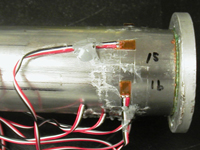Dynamic loading of fluid-filled tubes created by valve actuation is a well-known problem in power and processing plants. The change in fluid momentum is widely referred to as water hammer.
An elaborate theory of water hammer was first given by Skalak. The linear theory predicts that an impact will generate two waves; the primary wave will carry the main disturbance, accompanied by a precursor wave that has a much smaller amplitude of disturbance.
Now, Kazuaki Inaba at Tokyo Institute of Technology and Joseph E. Shepherd at California Institute of Technology have examined these predictions by conducting experiments over a range of impact speeds.
The researchers carried out tests in a unique facility using a gas gun mounted vertically above a tube filled with water. A projectile was accelerated, which then struck the water surface generating stress waves.
Comparison of their measurements with the theory indicates reasonable agreement between the predicted and measured peak strains as a function of the impact speed. However, they also found that the primary and precursor wave speeds were independent of the speed of impact.
The studies could find applications in damage reduction systems, where the precursor wave is monitored before the primary wave arrives.
Reference
- Authors: Kazuaki Inaba and Joseph E. Shepherd.
- Title of original paper: Flexural Waves in Fluid-Filled Tubes Subject to Axial Impact.
- Journal, volume, pages and year: Transactions of the ASME, Journal of Pressure Vessel Technology 132, 021302 (2010).
- Digital Object Identifier (DOI): 10.1115/1.4000510
- Affiliations: Department of Mechanical Sciences and Engineering, Tokyo Institute of Technology and Graduate Aerospace Laboratories, California Institute of Technology.
- Department website: http://www.3mech.titech.ac.jp/index_e.html


A bulge near the closed-end bottom created by reflection of the stress wave.
. Any information published on this site will be valid in relation to Science Tokyo.



